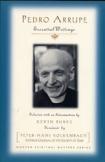What Eyes Have Seen
An icon bears witness. Maybe that’s why people who know about icons tell us to notice the eyes. The eyes more than anything else open us to the experience of the truth that lies behind an icon’s external representation.
It could also explain why this book begins with the eyesfirst those of St. Ignatius Loyola and then those of Pedro Arrupe. Ignatius, the founder of the Society of Jesus, wrote that at the Cardoner River in 1522 the eyes of his understanding were opened and though he saw no vision he understood and perceived many things. Five centuries later, Pedro Arrupe, the superior general of the Jesuits from 1965 to 1983, prayed to see everything with new eyes. Give me the clarity of understanding, Don Pedro asked, that you gave Ignatius.
Judging from this superbly selected volume of essential writings of Pedro Arrupe, there is no doubt that his prayers were answered. A cataclysmic awakening came on the morning of Aug. 6, 1945, when a B-29 dropped an atom bomb on the people of Hiroshima. At the time, Don Pedro, age 37, was the Jesuit master of novices in Nagatsuka, Japan, not far from the epicenter of the attack. Stunned by the sight of the destroyed city and the tens of thousands of numb and wounded Japanese who were fleeing the devastation, the Jesuits converted the novitiate into a hospital and began triage. Because of his earlier training as a medical student in Spain, Don Pedro reacted quickly to the emergency. He used his desk as an operating table and with a razor removed glass from the bodies of victims and debris from their eyes. He lanced body-length blisters caused by exposure to radiation, and dressed wounds with bandages made from freshly laundered sheets and underwear donated by the Jesuit community.
The apocalypse of Hiroshima opened his eyes to what is deadly and truly terrible about force and violence. Pedro Arrupe was convinced that the antidote to violence was a pedagogy of love. He complemented that mantra with unerring instincts about social systems, political theory and the human heart, and identified the dramatically urgent needs of the day. He challenged his brother Jesuits, graduates of Jesuit schools, Christians and all people to respond to those who were suffering, because yet another explosion is breeding in the womb of time, as millions die of hunger in sub-Saharan Africa, as human rights are still linked to the epidermis thus allowing racism to flourish, and as economic displacement, political exploitation and the distressing agony of refugees are still unnecessarily rampant in our world. He urged men and women of good will to stand with and for others and to aspire to a love beyond what most of us think of as loving. His faith made affective commitment to the church’s social Gospel not only possible but imperative.
For Jesuits—and for anyone else who would choose to see—Don Pedro found in the Spiritual Exercises and the life of Ignatius answers to the painful ethical and religious questions of our day. Service was a key. Pedro Arrupe was fond of pointing out that even when Ignatius was beset with romantic love and thoughts of a certain lady who had taken such a hold on his heart...he imagined what he would do in [her] servicethe verses, the words he would say to her, the deeds of arms he would do in her service. For Ignatius, to love was to serve.
Several touching selections close this book. Each reflects the pedagogy of love, service and poverty that were Father Arrupe’s defining themes. After suffering a stroke in 1981 that left him partially paralyzed and his speech severely impaired, Pedro Arrupe lived out what he wrote earlier of St. Ignatius: So far he had done what lay in his power: an unreserved surrender, a merciless purification, a spiritually discerned acceptance of God’s lights, [and] an availability for apostolic conversations and activity. It was, humanly speaking, all that was needed to ready him for the definitive sign. Father Arrupe called his final homily at the little chapel at La Storta, rich with Ignatian history, his Nunc Dimittis, recalling the prayer of the old man Simeon when he received the child Jesus in the temple: Now, Master, dismiss your servant in peacefor my eyes have seen your salvation (Lk 2:29-30).
Exactly what his eyes saw, we’ll never know. But after reading this powerful book of Father Arrupe’s writings, selected with intelligence and affection by Kevin Burke, S.J., we can be confident that God gave Don Pedro what he asked for: peace and a glimmer of the face of God.
An icon could expect nothing less.
This article also appeared in print, under the headline “What Eyes Have Seen,” in the April 18, 2005, issue.








